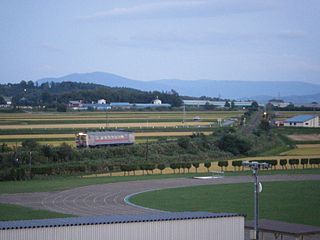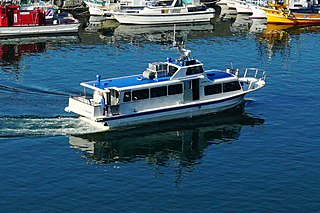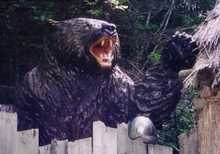
Tomamae is a town located in Rumoi Subprefecture, Hokkaido, Japan.

Hokkaido Television Broadcasting Co., Ltd. is a TV station in Sapporo, Hokkaidō, Japan. It is affiliated with the All-Nippon News Network (ANN)

The Sankebetsu brown bear incident, also known as the Rokusensawa bear attack or the Tomamae brown bear incident, was a series of bear attacks which took place 9-15 December 1915, at the beginning of the Taishō era, in a remote area of Hokkaido, Japan. Over the course of six snowy days, a male Ezo brown bear attacked a number of households, killing seven people and injuring a further three. The incident has been referred to as "the worst animal attack in Japanese history". The attacks ended when the hungry bear, so smart that it started to trick people, was shot dead.

Shinchō Kōki, Nobunaga Kōki is a chronicle of Oda Nobunaga, a daimyo of Japan's Sengoku period. It is also called Shinchō Ki, Nobunaga Ki (信長記). It was compiled after Nobunaga's death by Ōta Gyūichi (太田牛一), a vassal of Nobunaga, based on his notes and diary.
Rie Isogai was a 31-year-old Japanese office clerk who was robbed and murdered in Aichi Prefecture on the night of 24 August 2007 by three men who became acquainted through an underground message board. Because the three men met on an underground website, the case is frequently called the Dark Site Murder in Japan, "dark site" being the Japanese term for underground websites. Despite Japan's death penalty not normally being used in cases involving a single murder, Isogai's mother launched a petition to have the three killers face the death penalty; one was sentenced to death on 18 March 2009, while the other two were sentenced to life in prison on 13 April 2011.

The Rumoi Main Line is a Japanese railway line in Hokkaido operated by Hokkaido Railway Company which connects Fukagawa Station in Fukagawa and Ishikari-Numata Station in Numata. Following the discontinued service from Rumoi to Ishikari-Numata on April 1, the Rumoi Main Line is the shortest railway line in Japan, to be classified as a 'main line' at 14.4 kilometers.

The Ussuri brown bear, also known as the Ezo brown bear, Russian grizzly bear, or the black grizzly bear, is a subspecies of the brown bear or a population of the Eurasian brown bear. One of the largest brown bears, a very large Ussuri brown bear may approach the Kodiak bear in size. It is not to be confused with the North American grizzly bear.

The Hokkaido characters, also known as Aino characters or Ainu characters, are a set of characters discovered around 1886 on the Japanese island of Hokkaido. At the time of their discovery, they were believed to be a genuine script, but this view is not generally supported today.

Toshinari Masuda is a Japanese novelist, critic, and visiting professor of Nagoya University of Arts.

An earthquake measuring 6.6 on the moment magnitude scale struck Iburi Subprefecture in southern Hokkaido, Japan, on 6 September 2018 at 3:08 a.m. JST. The earthquake's epicenter was near Tomakomai and occurred at a depth of 35.0 kilometers (21.7 mi). The Japan Meteorological Agency (JMA) registered a magnitude of 6.7 Mj and a maximum intensity of 7 on the shindo scale. Shaking from the earthquake was felt strongly in Hokkaido and Aomori Prefecture, and shaking was felt as far away as the Kantō region. Long period ground motion (LPGM) during the earthquake reached maximum of class 4 on the JMA LPGM intensity scales. The earthquake disrupted electrical service throughout Hokkaido, leaving 5.3 million residents without power. Forty-one people were confirmed dead and six hundred and ninety-one were injured. The event is officially known as Heisei san-jū-nen Hokkaidō Iburi tōbu jishin.
Akane Chihaya is a Japanese writer. She has won the Shōsetsu Subaru New Writer Award, the Izumi Kyōka Prize for Literature, the Shimase Award for Love Stories, and the Naoki Prize.
Momoyo Koyama is a Japanese actress, voice actress and singer from Sapporo, Hokkaido, who is affiliated with Stardust Promotion. She is known for playing Sailor Mercury in two stage play adaptations of Sailor Moon in 2014 and 2015, and for playing Karen Aijō, the protagonist of the multimedia franchise Revue Starlight. She is also a member of the musical group SoundOrion.

TEAM NACS is a Japanese theatrical and musical unit that was formed in 1996 by Hiroyuki Morisaki, Ken Yasuda, Shigeyuki Totsugi, Yo Oizumi, and Takuma Oto'o. It is often called NACS (ナックス). Prior to October 2005, the group name was formerly TEAM-NACS. They belong to Creative Office Cue, an entertainment agency located in Sapporo, Hokkaido. They have a business alliance with Amuse Inc., a major entertainment agency in Tokyo, and have adopted a system that "Amuse handles all the work in the national wards other than Hokkaido".
Kenkaku Shōbai is a series of popular historical novels written by Shōtarō Ikenami and one of the representative novels of Ikenami along with Onihei Hankachō and Shikakenin Fujieda Baian. The stories were originally serialized in the monthly magazine Shōsetsu Shinchō between 1972 and 1989. Sixteen full-length novels were published from Shinchosha between 1973 and 1989. Kenkaku Shōbai was also adapted into TV programs and manga series.

Jakoman and Tetsu, also known as One-Eyed Captain and Tetsu is a 1964 Japanese film directed by Kinji Fukasaku based on an earlier screenplay by Akira Kurosawa and Senkichi Taniguchi that was based on the novel Nishin gyogyo by Keizo Kajino. The screenplay had previously been filmed by director Senkichi Taniguchi in 1949.

The Kazu I was a 19-ton tourist boat operating off the Hokkaido island of Japan, travelling around the Shiretoko Peninsula. The boat was operated by the Shiretoko Pleasure Cruise. The Shiretoko Peninsula, designated a natural World Heritage Site in 2005, is a popular destination for observing drift ice and rare animals.

Isami Nomura is a Japanese professional baseball Infielder for the Fukuoka SoftBank Hawks of Nippon Professional Baseball (NPB).
Expo Hokkaido '82 was an exhibition in Japan held at Tsukisamu Dome and outside fairgrounds, from June 12 - August 22, 1982.

Moritake Kimura was a Japanese non-fiction writer. He is best known for his investigation of the Sankebetsu brown bear incident, which caused the greatest damage in the history of Japanese animal damage.

Yamamoto Heikichi was a Japanese hunter. He is best known as a local hero for killing Kesagake, the giant brown bear involved in the Sankebetsu brown bear incident. He is reportedly to have killed over 300 brown bears in his lifetime. A resident of On'ne-no-sawa, Onishika, Rumoi District, Hokkaido, his main hunting grounds were the mountains of what was then Teshio Province, such as Mount Onishika.















